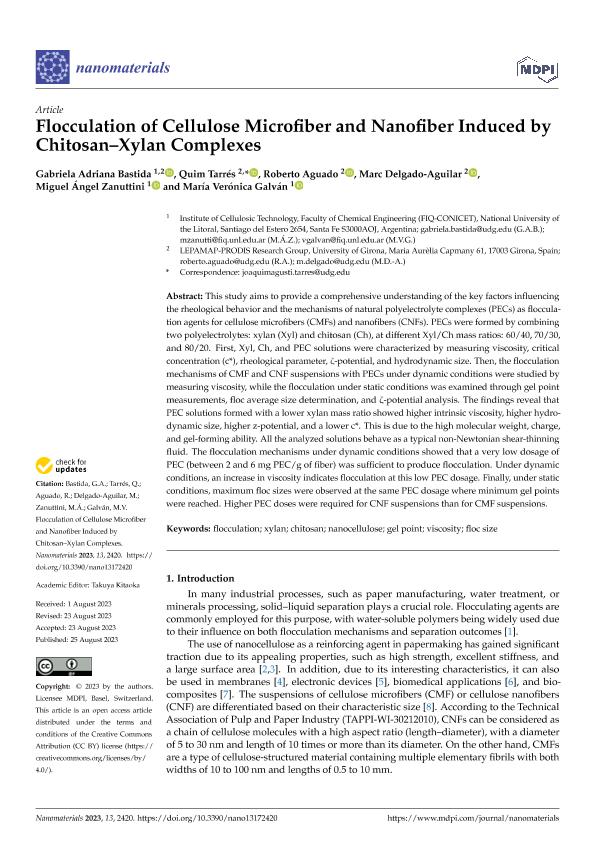Mostrar el registro sencillo del ítem
dc.contributor.author
Bastida, Gabriela Adriana

dc.contributor.author
Tarrés, Quim
dc.contributor.author
Aguado, Roberto
dc.contributor.author
Delgado Aguilar, Marc
dc.contributor.author
Zanuttini, Miguel Angel Mario

dc.contributor.author
Galván, María Verónica

dc.date.available
2024-01-26T14:14:59Z
dc.date.issued
2023-08
dc.identifier.citation
Bastida, Gabriela Adriana; Tarrés, Quim; Aguado, Roberto; Delgado Aguilar, Marc; Zanuttini, Miguel Angel Mario; et al.; Flocculation of Cellulose Microfiber and Nanofiber Induced by Chitosan–Xylan Complexes; MDPI; Nanomaterials; 13; 17; 8-2023; 1-15
dc.identifier.issn
2079-4991
dc.identifier.uri
http://hdl.handle.net/11336/224991
dc.description.abstract
This study aims to provide a comprehensive understanding of the key factors influencing the rheological behavior and the mechanisms of natural polyelectrolyte complexes (PECs) as flocculation agents for cellulose microfibers (CMFs) and nanofibers (CNFs). PECs were formed by combining two polyelectrolytes: xylan (Xyl) and chitosan (Ch), at different Xyl/Ch mass ratios: 60/40, 70/30, and 80/20. First, Xyl, Ch, and PEC solutions were characterized by measuring viscosity, critical concentration (c*), rheological parameter, ζ-potential, and hydrodynamic size. Then, the flocculation mechanisms of CMF and CNF suspensions with PECs under dynamic conditions were studied by measuring viscosity, while the flocculation under static conditions was examined through gel point measurements, floc average size determination, and ζ-potential analysis. The findings reveal that PEC solutions formed with a lower xylan mass ratio showed higher intrinsic viscosity, higher hydrodynamic size, higher z-potential, and a lower c*. This is due to the high molecular weight, charge, and gel-forming ability. All the analyzed solutions behave as a typical non-Newtonian shear-thinning fluid. The flocculation mechanisms under dynamic conditions showed that a very low dosage of PEC (between 2 and 6 mg PEC/g of fiber) was sufficient to produce flocculation. Under dynamic conditions, an increase in viscosity indicates flocculation at this low PEC dosage. Finally, under static conditions, maximum floc sizes were observed at the same PEC dosage where minimum gel points were reached. Higher PEC doses were required for CNF suspensions than for CMF suspensions.
dc.format
application/pdf
dc.language.iso
eng
dc.publisher
MDPI
dc.rights
info:eu-repo/semantics/openAccess
dc.rights.uri
https://creativecommons.org/licenses/by/2.5/ar/
dc.subject
CHITOSAN
dc.subject
FLOC SIZE
dc.subject
FLOCCULATION
dc.subject
GEL POINT
dc.subject
NANOCELLULOSE
dc.subject
VISCOSITY
dc.subject
XYLAN
dc.subject.classification
Otras Ingeniería de los Materiales

dc.subject.classification
Ingeniería de los Materiales

dc.subject.classification
INGENIERÍAS Y TECNOLOGÍAS

dc.title
Flocculation of Cellulose Microfiber and Nanofiber Induced by Chitosan–Xylan Complexes
dc.type
info:eu-repo/semantics/article
dc.type
info:ar-repo/semantics/artículo
dc.type
info:eu-repo/semantics/publishedVersion
dc.date.updated
2024-01-26T11:06:09Z
dc.journal.volume
13
dc.journal.number
17
dc.journal.pagination
1-15
dc.journal.pais
Suiza

dc.journal.ciudad
Basilea
dc.description.fil
Fil: Bastida, Gabriela Adriana. Universidad Nacional del Litoral. Facultad de Ingeniería Química. Instituto de Tecnología Celulósica; Argentina
dc.description.fil
Fil: Tarrés, Quim. Universidad de Girona; España
dc.description.fil
Fil: Aguado, Roberto. Universidad de Girona; España
dc.description.fil
Fil: Delgado Aguilar, Marc. Universidad de Girona; España
dc.description.fil
Fil: Zanuttini, Miguel Angel Mario. Universidad Nacional del Litoral. Facultad de Ingeniería Química. Instituto de Tecnología Celulósica; Argentina. Consejo Nacional de Investigaciones Científicas y Técnicas. Centro Científico Tecnológico Conicet - Santa Fe; Argentina
dc.description.fil
Fil: Galván, María Verónica. Universidad Nacional del Litoral. Facultad de Ingeniería Química. Instituto de Tecnología Celulósica; Argentina. Consejo Nacional de Investigaciones Científicas y Técnicas. Centro Científico Tecnológico Conicet - Santa Fe; Argentina
dc.journal.title
Nanomaterials
dc.relation.alternativeid
info:eu-repo/semantics/altIdentifier/url/https://www.mdpi.com/2079-4991/13/17/2420
dc.relation.alternativeid
info:eu-repo/semantics/altIdentifier/doi/http://dx.doi.org/10.3390/nano13172420
Archivos asociados
